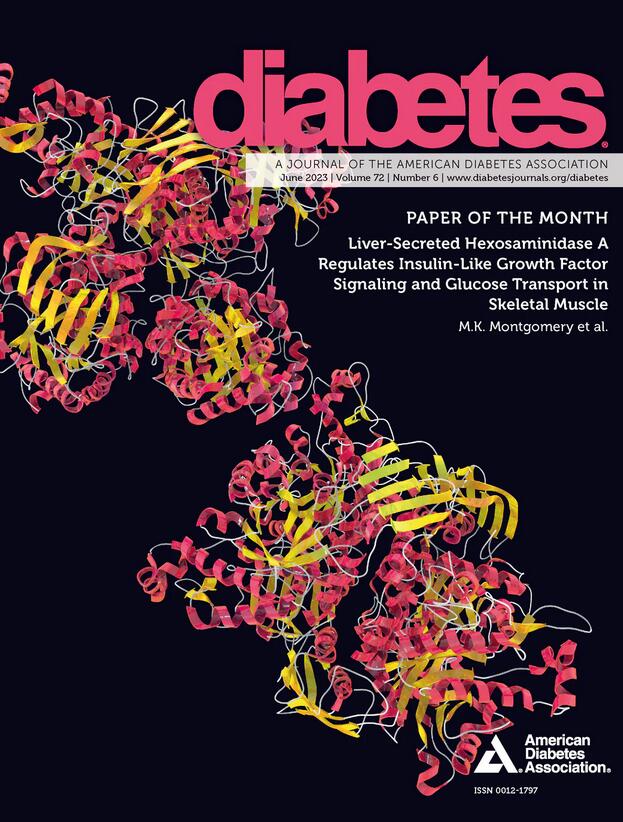β-细胞分泌能力预测人类胰岛移植后6年的代谢结果
IF 6.2
1区 医学
Q1 ENDOCRINOLOGY & METABOLISM
引用次数: 0
摘要
移植胰岛功能β细胞质量是通过急性胰岛素对葡萄糖增强精氨酸(AIRpot)的反应产生的β细胞分泌能力来测量的,然而,对于1型糖尿病患者,移植后一年以上的数据是有限的。我们通过单中心纵向分析评估了β细胞分泌能力的变化,并检查了胰岛细胞激素代谢和移植物功能的临床测量(混合膳食耐量试验[MMTT] c肽、β- 2评分和连续血糖监测[CGM])之间的关系。11名患者接受了纯化的人胰岛一次或两次门静脉内输注,以实现胰岛素独立性,随访时间中位数为6(5-7)年。β细胞分泌能力在3年内保持稳定,然后下降。空腹胰高血糖素和胰岛素原分泌比值与AIRpot呈负相关。功能β细胞质量为正常的40%预示着胰岛素的独立性,并通过MMTT c -肽-葡萄糖和β- 2评分强有力地预测。功能β细胞质量≤20%预示着良好的血糖结局,包括≤1%的时间≤60mg /dL,≤2%的时间≤180mg /dL和≥90%的时间范围≤70- 180mg /dL。β细胞替代方法应针对功能性β细胞质量的40%,以提供足够的胰岛储备以维持胰岛素独立性。MMTT c -肽-葡萄糖和β- 2评分可以告知临床环境中功能性β细胞质量的变化。本文章由计算机程序翻译,如有差异,请以英文原文为准。
β-Cell Secretory Capacity Predicts Metabolic Outcomes over 6 Years following Human Islet Transplantation
Transplanted islet functional β-cell mass is measured by the β-cell secretory capacity derived from the acute insulin response to glucose-potentiated arginine (AIRpot), however, data are limited beyond one-year post-transplant for individuals with type 1 diabetes. We evaluated changes in β-cell secretory capacity in a single-center longitudinal analysis and examined relationships with measures of islet cell hormone metabolism and clinical measures of graft function (mixed-meal tolerance test [MMTT] C-peptide, BETA-2 score, and continuous glucose monitoring [CGM]). Eleven individuals received purified human pancreatic islets over one or two intra-portal infusions to achieve insulin-independence and were followed over a median (IQR) 6 (5-7) years. β-cell secretory capacity remained stable over 3-years before declining. Fasting glucagon and proinsulin secretory ratios under glucose-potentiation were inversely correlated with AIRpot. A functional β-cell mass of 40% normal predicted insulin-independence and was strongly predicted by MMTT C-peptide-to-glucose and BETA-2 score. A functional β-cell mass of >20% predicted excellent glycemic outcomes including ≤1% time <60 mg/dL, ≤2% time >180 mg/dL and ≥90% time-inrange 70-180 mg/dL. β-cell replacement approaches should target a functional β-cell mass >40% to provide sufficient islet reserve for sustained insulin-independence. MMTT C-peptide-to-glucose and BETA-2 score can inform changes in functional β-cell mass in the clinical setting.
求助全文
通过发布文献求助,成功后即可免费获取论文全文。
去求助
来源期刊

Diabetes
医学-内分泌学与代谢
CiteScore
12.50
自引率
2.60%
发文量
1968
审稿时长
1 months
期刊介绍:
Diabetes is a scientific journal that publishes original research exploring the physiological and pathophysiological aspects of diabetes mellitus. We encourage submissions of manuscripts pertaining to laboratory, animal, or human research, covering a wide range of topics. Our primary focus is on investigative reports investigating various aspects such as the development and progression of diabetes, along with its associated complications. We also welcome studies delving into normal and pathological pancreatic islet function and intermediary metabolism, as well as exploring the mechanisms of drug and hormone action from a pharmacological perspective. Additionally, we encourage submissions that delve into the biochemical and molecular aspects of both normal and abnormal biological processes.
However, it is important to note that we do not publish studies relating to diabetes education or the application of accepted therapeutic and diagnostic approaches to patients with diabetes mellitus. Our aim is to provide a platform for research that contributes to advancing our understanding of the underlying mechanisms and processes of diabetes.
 求助内容:
求助内容: 应助结果提醒方式:
应助结果提醒方式:


